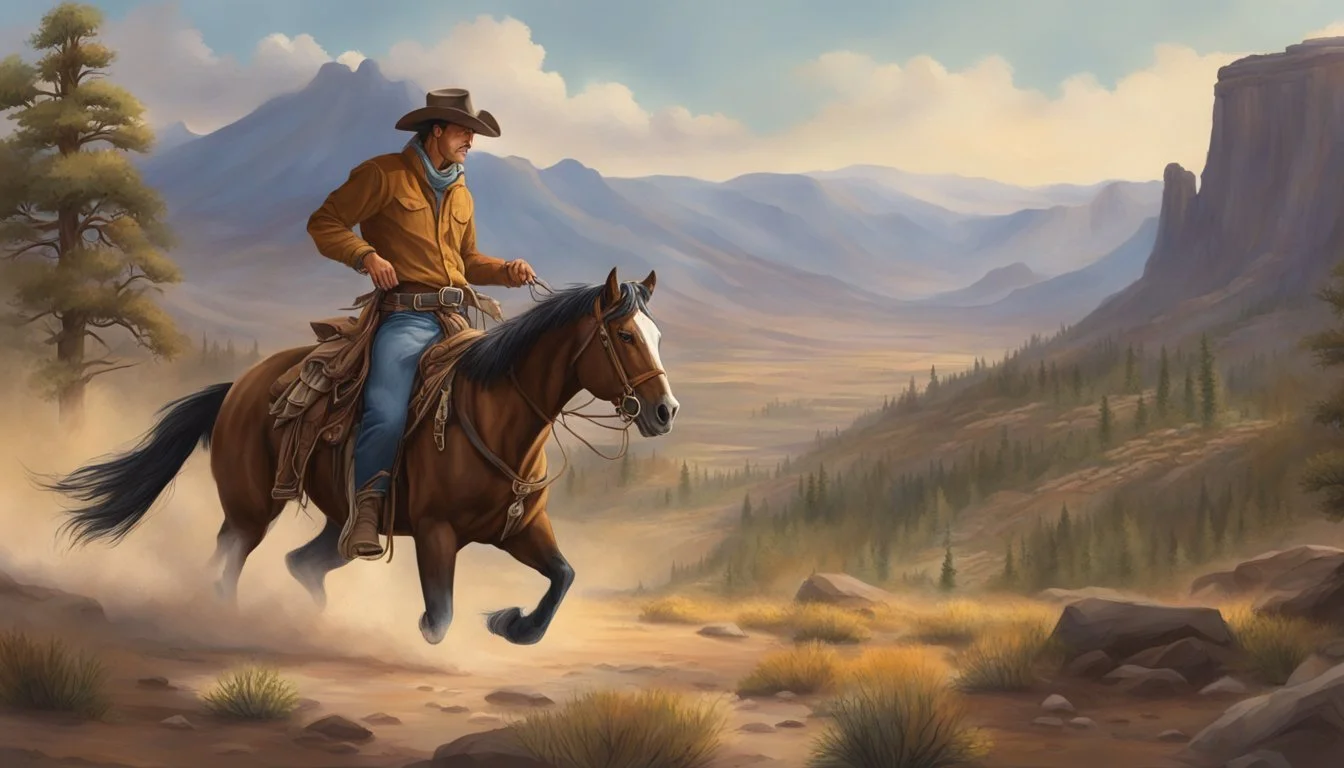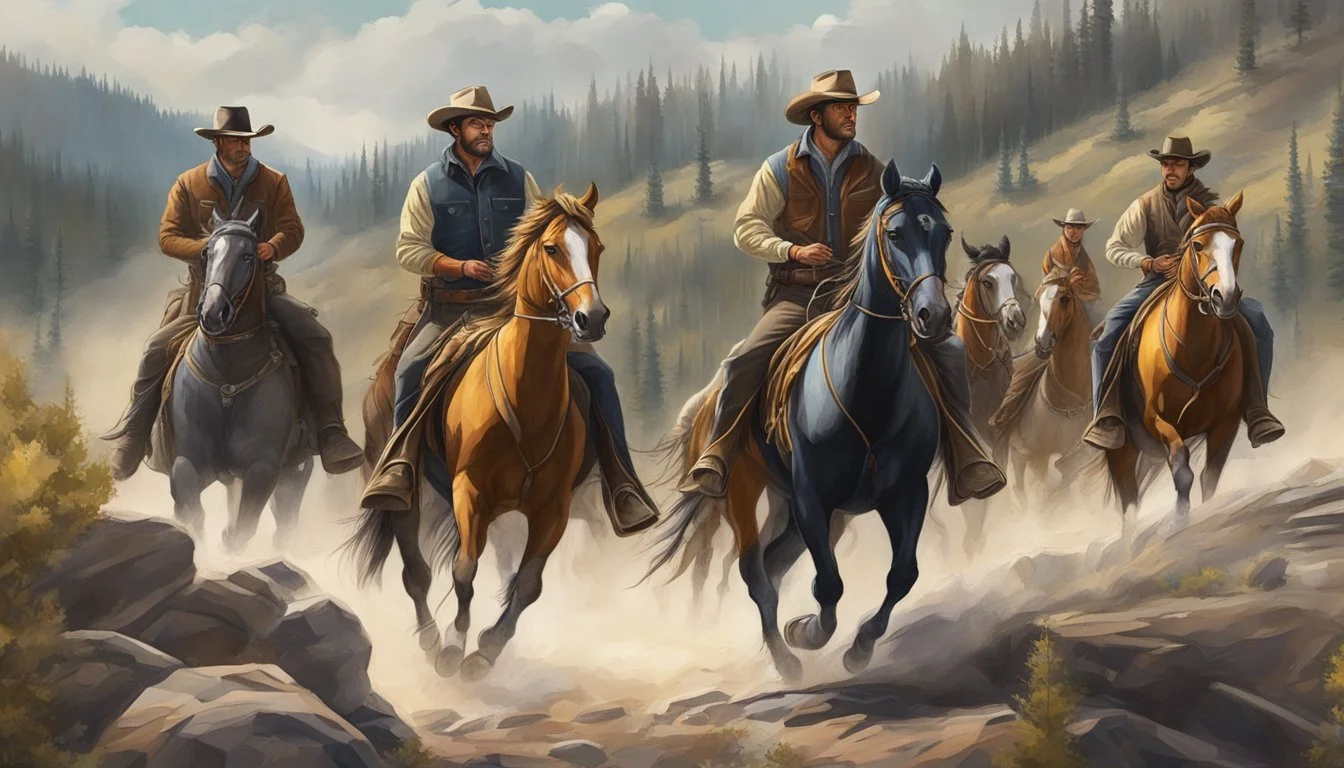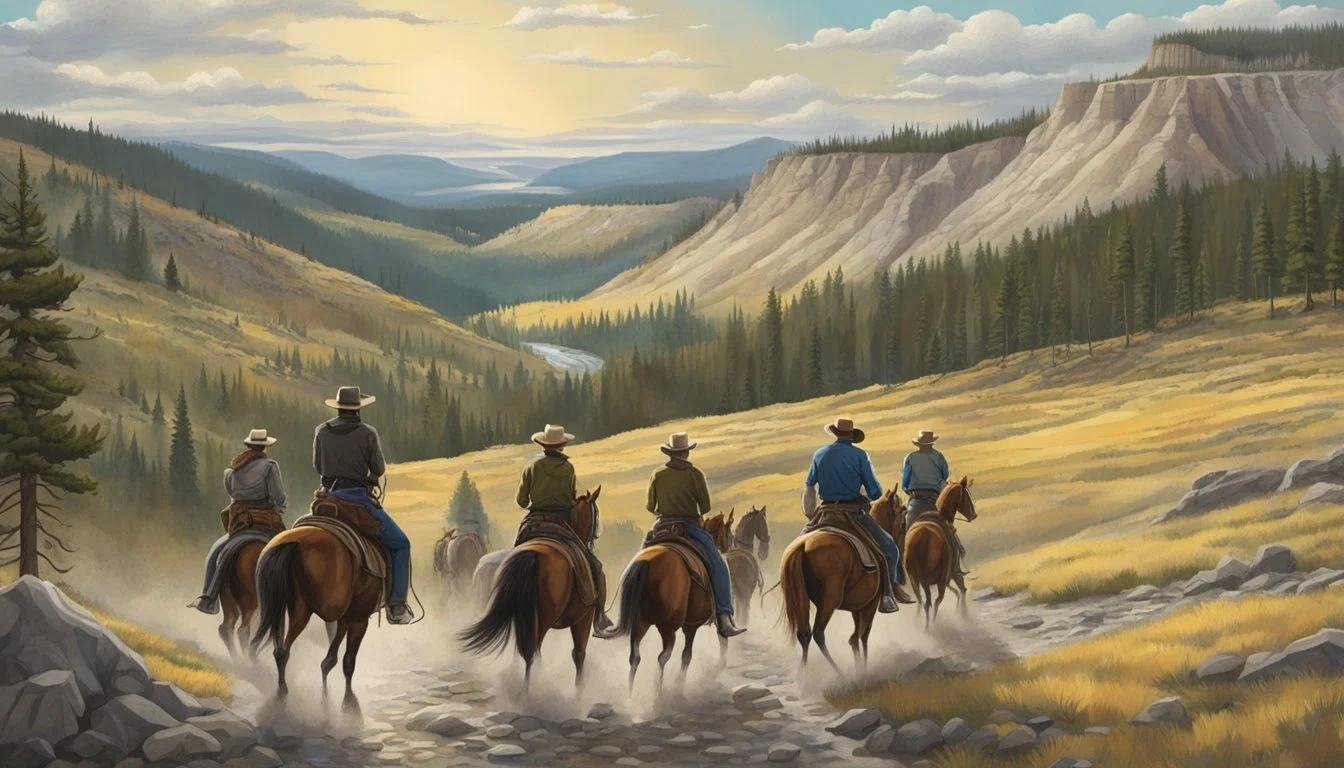Yellowstone's Wild Ride: How a TV Show is Reigniting America's Western Spirit
Yellowstone has taken America by storm, becoming a cultural phenomenon that captivates audiences across the nation. The show's rugged portrayal of Montana ranch life and complex family dynamics strikes a chord with viewers, tapping into the enduring myth of the American West. Yellowstone's success lies in its ability to present timeless themes of freedom, family, and vengeance through a lens of modern complexity.
The series explores how the myth of the West continues to shape national identity, questioning whether rugged individualism can survive in today's interconnected world. This blend of traditional Western values and contemporary challenges resonates deeply with American audiences, sparking discussions and influencing various aspects of life beyond entertainment.
Yellowstone's impact extends far beyond the screen, shaping fashion trends and boosting tourism to the picturesque landscapes featured in the show. Its authentic representation of rural values, coupled with high-stakes conflicts over land and legacy, has propelled it to become the most-watched show on television, reviving a genre that never truly faded from the American consciousness.
The Cultural Narrative of the American West
The American West holds a special place in the national imagination, shaping cultural narratives through generations. Its enduring mythology continues to captivate audiences through modern interpretations in film, television, and literature.
Exploring the Neo-Western Genre
Neo-Westerns reimagine classic Western themes in contemporary settings. They blend traditional elements with modern complexities, exploring the evolving American frontier. Shows like Yellowstone exemplify this genre, depicting ranchers and land conflicts in present-day Montana.
These productions maintain familiar Western motifs while addressing current issues. They often feature morally ambiguous characters navigating a changing landscape. Neo-Westerns resonate with viewers by connecting historical narratives to modern challenges.
Depicting the Myth of the West
The myth of the American West centers on rugged individualism and untamed wilderness. It romanticizes cowboys, outlaws, and frontier life. This idealized version of history has been perpetuated through popular culture for over a century.
Western mythology often overlooks historical realities and diverse perspectives. It tends to glorify Anglo-Saxon narratives while marginalizing other cultures. Despite these limitations, the mythical West remains a powerful symbol of American identity.
Movies, TV shows, and books continue to shape public perceptions of the Old West. They reinforce ideas of self-reliance, justice, and the pursuit of freedom.
Themes of Power and Freedom
Western narratives frequently explore themes of power and freedom. They depict struggles for control over land, resources, and communities. Characters often seek personal liberty in the face of encroaching civilization or oppressive forces.
Family dynamics play a central role in many Western stories. They examine generational conflicts and the preservation of family legacies. Power struggles within families mirror larger societal tensions.
The concept of freedom in Western mythology is complex. It encompasses both the allure of open spaces and the responsibilities of self-governance. Characters grapple with moral dilemmas as they navigate the fine line between liberty and lawlessness.
Historical Context and Authenticity
Yellowstone's portrayal of the American West blends historical elements with modern storytelling. The show draws inspiration from real events and cultural shifts spanning over a century, presenting a nuanced view of Western life and its evolving challenges.
Influence of Events in 1883 and 1923
The prequel series 1883 and 1923 provide crucial historical context for Yellowstone. 1883 depicts the Dutton family's arduous journey westward during the height of American expansion. This era saw massive migration, conflicts with indigenous peoples, and the harsh realities of frontier life.
1923 explores the aftermath of World War I and the onset of Prohibition. The series showcases the changing dynamics of the West, including technological advancements and economic challenges faced by ranchers. These historical backdrops enrich the main Yellowstone narrative, illustrating how past events shape present conflicts.
Historical Accuracy of the Yellowstone Narrative
Yellowstone strives for authenticity in its portrayal of modern ranch life. The show incorporates real ranching skills and accurate depictions of regional issues. Storylines often mirror contemporary challenges faced by Western communities, such as land disputes and resource conflicts.
The series explores the tension between traditional ways of life and modern pressures. It accurately portrays the economic realities of maintaining large ranches in the face of development and changing land use. This attention to detail lends credibility to the fictional narrative.
Native American Rights and Representation
Yellowstone addresses complex issues surrounding Native American rights and representation. The show depicts ongoing land disputes between indigenous communities and white settlers, reflecting real historical and contemporary conflicts.
Native American characters are portrayed with depth, showcasing their struggles to maintain cultural identity and sovereignty. The series explores themes of tribal politics, reservation life, and the impact of historical injustices on present-day indigenous communities.
Yellowstone's treatment of these issues adds layers of complexity to the narrative, highlighting the ongoing challenges faced by Native Americans in the modern West.
Dissecting the Core of Yellowstone
Yellowstone's appeal stems from its intricate portrayal of family dynamics, character-driven narratives, and conflicts over land and legacy in the modern American West.
Complex Characters and Family Loyalty
John Dutton stands at the center of Yellowstone's narrative, leading a clan bound by blood and shared history. The Dutton family's loyalty is tested through external threats and internal conflicts. Each family member grapples with their role in preserving the ranch and their place within the family hierarchy.
Yellowstone presents morally ambiguous characters, eschewing simple hero-villain dichotomies. This complexity resonates with viewers who recognize the shades of gray in real-life relationships and decisions.
The show explores how family ties can both strengthen and constrain individuals, reflecting the challenges many face in balancing personal aspirations with familial obligations.
Storytelling Driven by Character Development
Yellowstone's narrative unfolds through the growth and transformation of its characters. The series dedicates time to exploring each character's motivations, fears, and aspirations.
Key character arcs include:
Beth Dutton's journey from ruthless businesswoman to vulnerable partner
Jamie Dutton's struggle with identity and belonging
Kayce Dutton's conflict between ranch life and family responsibilities
These evolving storylines keep viewers invested in the characters' fates. The show's pacing allows for deep dives into emotional landscapes, creating a rich tapestry of interpersonal drama.
Yellowstone's writers skillfully weave together individual character journeys with the overarching plot, ensuring that personal growth drives the story forward.
Land Ownership and Legacy Battles
The Yellowstone Ranch serves as more than a backdrop; it's a character in its own right. The series explores the complexities of land ownership in the modern West, touching on issues such as:
Development pressures from outside investors
Conflicts with Native American tribes over historical land claims
Environmental concerns and conservation efforts
Legacy plays a crucial role in the show's narrative. John Dutton's determination to preserve his family's legacy often clashes with changing economic and social realities.
The series depicts the challenges of maintaining a traditional way of life in a rapidly modernizing world. It raises questions about the sustainability of large-scale ranching and the cultural significance of the American frontier myth.
The Impact of Yellowstone on Popular Culture
Yellowstone has profoundly influenced American television and society, shaping entertainment standards, fashion trends, and viewer demographics. Its cultural footprint extends far beyond the screen, resonating with audiences across diverse backgrounds.
Elevating the Standard of Television Drama
Yellowstone has raised the bar for television drama with its cinematic quality and complex storytelling. The show's high production values, including stunning cinematography of Western landscapes, have set a new benchmark for visual excellence in TV series. Its nuanced character development and exploration of moral dilemmas have captivated viewers, prompting deeper engagement with the narrative.
The series tackles contemporary issues like land ownership, environmental conservation, and Native American rights, adding depth to its Western setting. This blend of traditional themes with modern concerns has broadened the appeal of the genre, attracting both long-time Western fans and new audiences.
Influence on Fashion and Lifestyle
Yellowstone's impact on fashion has been significant, sparking a resurgence of Western-inspired clothing and accessories. Cowboy hats, boots, and rugged outerwear have seen increased popularity since the show's debut. Major retailers have reported spikes in sales of items similar to those worn by characters on the show.
The series has also influenced lifestyle choices, with some viewers showing increased interest in ranch life and outdoor activities. This has led to a boost in Western-themed tourism, with fans visiting filming locations and similar landscapes featured in the show.
Social media platforms have seen a surge in Yellowstone-related content, from fashion inspiration to location photography, further amplifying the show's cultural impact.
Fostering a Diverse Fan Base
Yellowstone has successfully bridged demographic divides, attracting a wide range of viewers across age groups and geographic locations. Its themes of family, tradition, and power struggles resonate with diverse audiences, creating a shared cultural experience.
The show's popularity has sparked discussions on social media and in everyday conversations, fostering a sense of community among fans. This engagement extends to merchandise sales, with Yellowstone-branded products becoming increasingly popular.
Fan theories, discussions, and reactions to plot developments have become common topics online, demonstrating the emotional impact of the series. This level of engagement has contributed to the show's longevity and cultural staying power.
Visual Storytelling and Cinematic Craftsmanship
Yellowstone's visual storytelling and cinematic craftsmanship play a crucial role in captivating audiences. The show's stunning imagery and high production values transport viewers to the rugged beauty of Montana's landscapes.
Breathtaking Vistas and Diverse Terrain
Montana's diverse terrain serves as a captivating backdrop for Yellowstone's narrative. Sweeping shots showcase vast prairies, snow-capped mountains, and pristine rivers. The show's cinematography highlights the changing seasons, from lush summer meadows to stark winter landscapes.
Iconic locations like the Yellowstone ranch and surrounding wilderness become characters in their own right. These awe-inspiring vistas reinforce the show's themes of freedom, isolation, and man's relationship with nature.
The visual spectacle of Montana's landscapes contributes significantly to Yellowstone's appeal, drawing viewers into the world of the Dutton family.
Environmental Concerns and Wildlife Protection
Yellowstone incorporates environmental themes into its visual storytelling. The show depicts the delicate balance between ranching, development, and wildlife conservation.
Scenes featuring native wildlife, such as bison, wolves, and grizzly bears, underscore the region's ecological importance. These moments serve to educate viewers about local fauna and their habitats.
The series also portrays conflicts arising from land use and conservation efforts. Visual cues highlight the impact of human activity on the natural environment, prompting viewers to consider real-world environmental challenges.
Cinematography and High Production Values
Yellowstone's cinematography elevates the viewing experience through meticulous attention to detail. The show employs a range of techniques to capture the essence of the American West:
Aerial shots that showcase the vastness of the landscape
Intimate close-ups that reveal character emotions
Dynamic action sequences that heighten tension
High production values are evident in every aspect of the show:
Authentic set designs and costumes
Carefully choreographed horseback riding scenes
Seamless integration of visual effects
The combination of skilled cinematography and top-notch production creates a visually stunning and immersive experience for viewers.
The Role of Yellowstone in Contemporary Society
Yellowstone has emerged as a cultural touchstone, reflecting and shaping perspectives on modern American life. The series explores complex themes that resonate deeply with viewers across the country.
Exploring Rural Values and American Life
Yellowstone offers a window into ranching culture and rural values. The show depicts the challenges faced by ranchers in maintaining their way of life. It showcases the tight-knit communities and strong work ethic characteristic of rural America.
The Dutton family's struggle to preserve their ranch resonates with viewers grappling with rapid societal changes. This portrayal taps into nostalgia for a romanticized version of the American West.
Yellowstone's authenticity in representing rural life has contributed to its widespread appeal. The series highlights the importance of family, tradition, and connection to the land.
Addressing Cultural Tensions and Moral Ambiguity
Yellowstone delves into the complex cultural tensions present in contemporary America. The show explores conflicts between traditional ways of life and modern progress.
It presents morally ambiguous characters, forcing viewers to confront difficult ethical questions. The series doesn't shy away from portraying the darker aspects of human nature and the compromises people make to survive.
Yellowstone addresses issues of power, corruption, and justice in a nuanced manner. It reflects the moral complexities faced by individuals and communities in today's society.
The show's exploration of these themes has sparked discussions among viewers about ethics and morality in modern life.
Creating Conversations Around Justice and Preservation
Yellowstone brings important conversations about justice and preservation to the forefront. The series highlights the ongoing struggles between different groups over land rights and resources.
It explores environmental concerns, showcasing the beauty of the American West while addressing threats to its preservation. The show raises awareness about the delicate balance between development and conservation.
Yellowstone also touches on indigenous perspectives, presenting complex relationships between Native American tribes and other stakeholders. This representation has sparked discussions about historical injustices and current challenges faced by indigenous communities.
The series prompts viewers to consider the importance of preserving natural and cultural heritage for future generations.
The Endurance of Yellowstone's Narrative
Yellowstone's narrative has demonstrated remarkable staying power, captivating audiences with its blend of Western themes and contemporary conflicts. The show's ability to evolve while maintaining its core identity has been key to its enduring success.
Contributions to the Western Narrative Tradition
Yellowstone breathes new life into the Western genre by adapting classic tropes for modern audiences. The show portrays the rugged individualism of the American West through the lens of present-day challenges. Land disputes, family loyalty, and power struggles take center stage, echoing timeless Western themes.
The Dutton family's fight to preserve their ranch resonates with viewers, tapping into fears about the erosion of traditional ways of life. Yellowstone's creators skillfully weave these concerns into a narrative that feels both familiar and fresh.
By setting the story in the present day, the show explores how Western values clash with modern realities. This approach allows Yellowstone to contribute meaningfully to the ongoing Western narrative tradition.
Longevity Through Spin-off Series
Yellowstone's universe has expanded through strategic spin-offs, ensuring the narrative's longevity. These additional series explore different time periods and locations within the Dutton family saga.
1883: Delves into the Dutton family's origins
1923: Examines the challenges faced by an earlier generation
6666: Focuses on the legendary Four Sixes Ranch in Texas
These spin-offs broaden the scope of the Yellowstone story, attracting new viewers while satisfying existing fans. By exploring various eras, the franchise maintains relevance and avoids stagnation.
The interconnected nature of these series creates a rich tapestry of storytelling, encouraging viewers to invest in the extended Dutton family history.
Evolving Storylines and Character Arcs
Yellowstone's narrative endures through its commitment to character development and evolving storylines. The show's ensemble cast allows for multiple interwoven plot threads, keeping the narrative fresh and engaging.
Key characters undergo significant transformations:
John Dutton: Evolves from a staunch traditionalist to a more complex figure
Beth Dutton: Reveals layers beneath her tough exterior
Jamie Dutton: Grapples with loyalty and ambition
These character arcs provide depth and nuance, sustaining viewer interest over multiple seasons. The show's writers continually introduce new conflicts and alliances, preventing the narrative from becoming predictable.
Yellowstone also addresses contemporary issues like land development and Native American rights, ensuring its relevance to modern audiences. This blend of character-driven drama and topical themes contributes to the narrative's enduring appeal.
Creator's Insight and Behind the Scenes
Taylor Sheridan's vision, the ensemble cast's performances, and authentic filming locations combine to bring the world of Yellowstone to life. These elements contribute to the show's resonance with American audiences.
Taylor Sheridan's Vision and Influence
Taylor Sheridan, the creator of Yellowstone, draws from his experiences growing up on a Texas ranch. His deep understanding of Western culture infuses authenticity into the series. Sheridan's storytelling approach blends classic Western themes with contemporary issues.
He focuses on land preservation, family dynamics, and power struggles. This combination appeals to a wide range of viewers. Sheridan's hands-on approach extends to directing episodes and working closely with the cast.
His dedication to realism is evident in the show's attention to detail. From cowboy attire to ranch operations, Sheridan ensures accuracy in every aspect.
The Ensemble Cast's Performances
The talented ensemble cast brings depth and complexity to their characters. Kevin Costner anchors the series as John Dutton, the patriarch of the Dutton family. His portrayal exudes strength and vulnerability.
Kelly Reilly delivers a standout performance as Beth Dutton. She captures Beth's fierce loyalty and sharp wit. Luke Grimes and Wes Bentley portray the conflicted Dutton sons with nuance and intensity.
The actors' chemistry enhances the family dynamics central to the show. Their performances bring authenticity to the complex relationships between characters.
The cast's commitment to their roles extends beyond the screen. Many actors learned ranching skills to portray their characters convincingly.
Filming Locations and Authentic Ranch Experience
Yellowstone's stunning visuals come from filming on location in Montana and Utah. The Chief Joseph Ranch in Darby, Montana, serves as the iconic Dutton ranch. This working cattle ranch provides an authentic backdrop for the series.
The production team utilizes various Montana locations to capture the state's diverse landscapes. From rolling prairies to rugged mountains, these settings enhance the show's visual appeal.
Filming on real ranches allows the cast to immerse themselves in the cowboy lifestyle. This immersion contributes to the authenticity of their performances. The crew works closely with local ranchers to ensure accurate depictions of ranch life.





